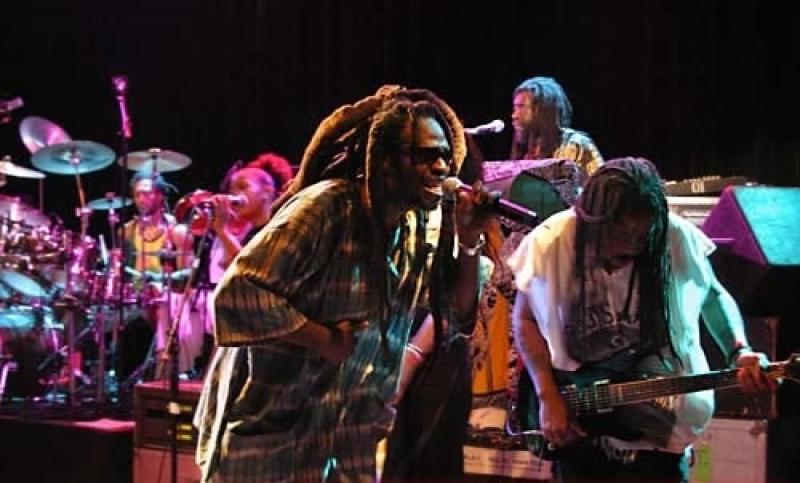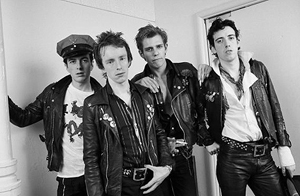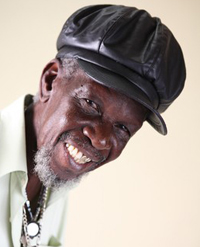Reggae Britannia/ Rocksteady: The Roots of Reggae, BBC Four | reviews, news & interviews
Reggae Britannia/ Rocksteady: The Roots of Reggae, BBC Four
Reggae Britannia/ Rocksteady: The Roots of Reggae, BBC Four
From Trenchtown to Camden Town with the Beeb's Reggae Britannia season

BBC Four's Britannia series keeps it simple - it tells the story in a straight line, illustrates it with as much archive material as the budget will allow, and interviews as many key protagonists as it can find. If the subject is strong enough, you'll get a good film out of it.
And so it was with the reggae edition (part of the Reggae Britannia season), which took a brisk 90-minute march from reggae's arrival in Britain from Jamaica in the Sixties to the point where it disappeared into Soul II Soul's dub/soul/R&B mixture. They'd rounded up pretty well everybody who ever had a stake in Brit-reggae and its various tributaries, from Don Letts and Jerry Dammers to members of Aswad, Steel Pulse and UB40.
Paul Simonon of the reggae-infatuated Clash (pictured below) recalled how himself and Joe Strummer had tried to set fire to a car during riots at the Notting Hill Carnival, and explained that The Clash's version of Junior Murvin's "Police and Thieves" had never set out to be reggae, but a punk band's idiosyncratic interpretation of it. Stewart Copeland of The Police, the band who cleaned up globally by turning reggae into white mainstream pop, was delightfully unapologetic. "We completely bastardised reggae," he beamed. "We plundered it without remorse."
 Reggae might never have happened in Britain without the entrepreneurial zeal of Island Records's Chris Blackwell, who these days resembles a veteran diplomat reciting extracts from his memoirs. His influence was immense, though the film avoided discussion of the colonialist overtones of a wealthy white Jamaican cashing in on black music.
Reggae might never have happened in Britain without the entrepreneurial zeal of Island Records's Chris Blackwell, who these days resembles a veteran diplomat reciting extracts from his memoirs. His influence was immense, though the film avoided discussion of the colonialist overtones of a wealthy white Jamaican cashing in on black music.
Reggae's most remarkable trait has been its adaptability, enabling it to form fruitful partnerships with punk, soul and pop, become a thunderous medium for black political consciousness in the hands of Linton Kwesi Johnson or Steel Pulse, and fly the flag for multiracial Britain via UB40 or The Specials. The film fizzled out rather weakly as reggae's identity grew diffuse, but I suppose you could say form mirrored function.
Rocksteady: The Roots of Reggae was a nostalgic trip back to mid-Sixties Jamaica, and the arrival of the "rocksteady" style which formed a bridge between ska and reggae. Hopeton Lewis, whose track "Take it Easy" urged "take it down, no need to hurry", explained that he started singing rocksteady because ska went too fast and he couldn't keep up.
The differences between rocksteady and reggae aren't instantly obvious - Bob Marley arrived at the tail end of the former and struck it rich with the latter - and it seemed that many songs tagged as reggae are probably rocksteady. When Blondie covered "The Tide is High", for instance, everyone thought they were playing reggae, but here was Marcia Griffiths singing it amidst a grand reunion of Jamaica's veteran rocksteady artists for a one-off concert in Kingston.
 The film (an expensively shot Swiss-Canadian co-production) used the gathering of the artists, many of whom hadn't seen each other for 40 years, as a pretext for a folk history of Jamaica, with the endearingly grizzled Wilburn "Stranger" Cole acting as narrator (pictured left). Many of the performers were fragile in health, but the years visibly fell away as they gathered to sing their old hits, many of which packed a searing emotional wallop. Judy Mowatt's "Silent River Runs Deep" was a beautiful soul-gospel mix, while "Equal Rights" was sung with bubbling energy by Leroy Sibbles and three old mates on the Kingston seafront.
The film (an expensively shot Swiss-Canadian co-production) used the gathering of the artists, many of whom hadn't seen each other for 40 years, as a pretext for a folk history of Jamaica, with the endearingly grizzled Wilburn "Stranger" Cole acting as narrator (pictured left). Many of the performers were fragile in health, but the years visibly fell away as they gathered to sing their old hits, many of which packed a searing emotional wallop. Judy Mowatt's "Silent River Runs Deep" was a beautiful soul-gospel mix, while "Equal Rights" was sung with bubbling energy by Leroy Sibbles and three old mates on the Kingston seafront.
In between, there were stories about how vibrant and optimistic Jamaica had seemed in the Sixties, after becoming independent from Britain in 1962 and before drugs and gang warfare took hold. Old news footage of the bustling Jamaica railway, which used to bring villagers to the city to find work, contrasted dismally with scenes of the now-derelict railway station. A lack of jobs had prompted waves of emigration, mainly to the USA. It was enough to bring a tremble to the lower lip.
- Find Rocksteady: The Roots of Reggae on Amazon
- Watch Reggae Britannia on BBC iPlayer
Explore topics
Share this article
The future of Arts Journalism
You can stop theartsdesk.com closing!
We urgently need financing to survive. Our fundraising drive has thus far raised £49,000 but we need to reach £100,000 or we will be forced to close. Please contribute here: https://gofund.me/c3f6033d
And if you can forward this information to anyone who might assist, we’d be grateful.

Subscribe to theartsdesk.com
Thank you for continuing to read our work on theartsdesk.com. For unlimited access to every article in its entirety, including our archive of more than 15,000 pieces, we're asking for £5 per month or £40 per year. We feel it's a very good deal, and hope you do too.
To take a subscription now simply click here.
And if you're looking for that extra gift for a friend or family member, why not treat them to a theartsdesk.com gift subscription?
more TV
 The Diplomat, Season 3, Netflix review - Ambassador Kate Wyler becomes America's Second Lady
Soapy transatlantic political drama keeps the Special Relationship alive
The Diplomat, Season 3, Netflix review - Ambassador Kate Wyler becomes America's Second Lady
Soapy transatlantic political drama keeps the Special Relationship alive
 The Perfect Neighbor, Netflix review - Florida found-footage documentary is a harrowing watch
Sundance winner chronicles a death that should have been prevented
The Perfect Neighbor, Netflix review - Florida found-footage documentary is a harrowing watch
Sundance winner chronicles a death that should have been prevented
 Murder Before Evensong, Acorn TV review - death comes to the picturesque village of Champton
The Rev Richard Coles's sleuthing cleric hits the screen
Murder Before Evensong, Acorn TV review - death comes to the picturesque village of Champton
The Rev Richard Coles's sleuthing cleric hits the screen
 Black Rabbit, Netflix review - grime and punishment in New York City
Jude Law and Jason Bateman tread the thin line between love and hate
Black Rabbit, Netflix review - grime and punishment in New York City
Jude Law and Jason Bateman tread the thin line between love and hate
 The Hack, ITV review - plodding anatomy of twin UK scandals
Jack Thorne's skill can't disguise the bagginess of his double-headed material
The Hack, ITV review - plodding anatomy of twin UK scandals
Jack Thorne's skill can't disguise the bagginess of his double-headed material
 Slow Horses, Series 5, Apple TV+ review - terror, trauma and impeccable comic timing
Jackson Lamb's band of MI5 misfits continues to fascinate and amuse
Slow Horses, Series 5, Apple TV+ review - terror, trauma and impeccable comic timing
Jackson Lamb's band of MI5 misfits continues to fascinate and amuse
 Coldwater, ITV1 review - horror and black comedy in the Highlands
Superb cast lights up David Ireland's cunning thriller
Coldwater, ITV1 review - horror and black comedy in the Highlands
Superb cast lights up David Ireland's cunning thriller
 Blu-ray: The Sweeney - Series One
Influential and entertaining 1970s police drama, handsomely restored
Blu-ray: The Sweeney - Series One
Influential and entertaining 1970s police drama, handsomely restored
 I Fought the Law, ITVX review - how an 800-year-old law was challenged and changed
Sheridan Smith's raw performance dominates ITV's new docudrama about injustice
I Fought the Law, ITVX review - how an 800-year-old law was challenged and changed
Sheridan Smith's raw performance dominates ITV's new docudrama about injustice
 The Paper, Sky Max review - a spinoff of the US Office worth waiting 20 years for
Perfectly judged recycling of the original's key elements, with a star turn at its heart
The Paper, Sky Max review - a spinoff of the US Office worth waiting 20 years for
Perfectly judged recycling of the original's key elements, with a star turn at its heart
 The Guest, BBC One review - be careful what you wish for
A terrific Eve Myles stars in addictive Welsh mystery
The Guest, BBC One review - be careful what you wish for
A terrific Eve Myles stars in addictive Welsh mystery
 theartsdesk Q&A: Suranne Jones on 'Hostage', power pants and politics
The star and producer talks about taking on the role of Prime Minister, wearing high heels and living in the public eye
theartsdesk Q&A: Suranne Jones on 'Hostage', power pants and politics
The star and producer talks about taking on the role of Prime Minister, wearing high heels and living in the public eye

Add comment